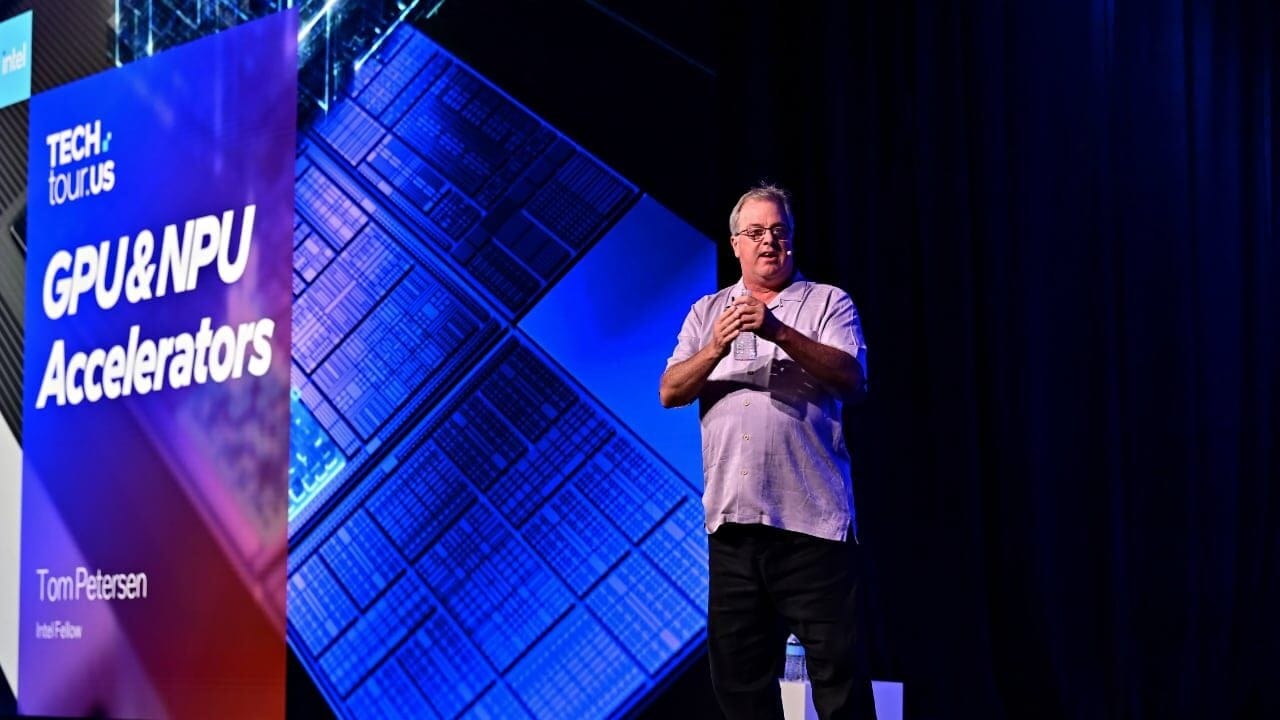Intel’s pitch for better gaming on thin-and-light laptops is simple: stop relying on brute force. Tom Peterson’s keynote lays out a three-part plan. First, a faster Xe3 GPU core. Second, “smart rendering” that uses AI to generate frames between frames. Third, platform-aware tuning that keeps the CPU and GPU from fighting each other and causing stutter. The goal is smooth, high frame rates with lower power draw.
Xe3: the GPU upgrade doing the heavy lifting
Xe3 is the next graphics IP in Panther Lake, with a claimed 50% performance uplift over Lunar Lake in most games. Cache, registers, and ray tracing blocks all get smarter.
- 33% larger L1 cache and improved register allocation
- More threads in the Xe Vector Engine
- Enhanced ray tracing units
- Frame-time gains from bigger L2 and smarter registers, reducing spills
Rather than chasing bigger watt budgets, Xe3 squeezes more from every cycle. The larger caches and better register policy reduce stalls and spills, which show up directly in frame-time graphs as shaved milliseconds. That is the kind of change you feel as less hitching and steadier FPS, not just a nice bar in a benchmark.
Smart rendering: AI fills the gaps between frames
Intel wants fewer pixels rasterised and more pixels generated. XCSS MFG uses optical flow and AI to analyse two rendered frames and synthesise up to three in-between, lifting perceived smoothness by as much as four times.
- XCSS MFG = Multi-Frame Generation via AI + optical flow
- Up to three new frames between two rendered frames
- Live demo showed native looked choppy in slow-mo vs MFG, which stayed smooth
- PresentMon now reports FPS App vs FPS Presents for transparency
If most pixels are generated rather than rasterised, laptops no longer need a monster GPU to feel fast. Multi-frame generation boosts motion fluidity at modest power. Separating “what the app renders” from “what you actually see” with PresentMon’s two metrics keeps the marketing honest.
Platform-aware tuning: killing stutter at the source
Stutter often comes from the CPU and GPU fighting over power. Intel’s platform-aware approach pre-compiles shaders in the cloud and uses Intelligent Bias Control v3 with E-Core-first scheduling to stabilise delivery to the GPU. Intel cites a 10%+ average FPS lift and 25% better lows.
- Cloud-compiled shaders pulled via Intel Graphics Software
- Smoother PID power controller that knows when a game is active
- E-Core-first scheduling moves game threads to efficient cores
- More stable GPU power, higher averages, fewer 1% low dips
Shader compilation spikes and erratic power sharing are classic hitch factories. Pre-compiling trims day-one stutter and load times. Smarter power control plus E-Core scheduling gives the GPU a steadier budget, which shows up as fewer hitches during busy scenes.
Measuring what you actually feel
Intel’s updated PresentMon shows both native raster performance (FPS App) and final displayed rate with frame gen (FPS Presents). That split should help reviewers and buyers compare like-for-like instead of mixing raster FPS with generated frames.
- FPS App = baseline engine performance
- FPS Presents = what hits your eyes after frame gen
- Aligns expectations for laptop reviews and buyer guides
If you only quote the big number from frame generation, you miss the true capability of the GPU. If you only quote raster, you ignore real-world smoothness. Reporting both makes it harder to cherry-pick a story.
What to do if you buy into this
Leave the clever bits on. Enable XCSS MFG in supported games, keep shader pre-compilation active, and judge performance using both FPS metrics.
- Turn on XCSS MFG for smooth motion at lower power
- Keep pre-compiled shaders enabled to avoid first-launch stutter
- Use FPS App and FPS Presents when testing your setup
These features exist to smooth out the worst parts of laptop gaming: inconsistent frame delivery and hitching. Disabling them for the sake of “purity” just gives you slower loads and uglier frame-time graphs.
What is Xe3?It’s Intel’s next-gen graphics IP for Panther Lake with architectural changes like bigger caches, better register policies and improved RT, targeting a significant uplift over Lunar Lake.
How does XCSS MFG work?It analyses two rendered frames with optical flow and generates up to three in between, raising perceived smoothness without the same power cost as rendering every frame.
Is frame generation “fake FPS”?No. It’s different FPS. PresentMon now shows FPS App for native raster and FPS Presents for what you see, so reviewers can report both.
Will this reduce stutter in new games?Yes, that’s the idea. Pre-compiled shaders cut first-run hitching and Intelligent Bias Control v3 stabilises GPU power with E-Core-first scheduling.
What should I enable on day one?XCSS MFG where supported, cloud shader downloads in Intel Graphics Software, and measure with both FPS metrics.
Related reading on Tbreak
- Our Mac gaming reality check: Cyberpunk 2077 on Apple Silicon (context on performance and upscaling) — read the benchmark
- Choosing a GPU-capable creator laptop? Start here — laptop for photo editing guide
- Prebuilt power that won’t throttle under load — Acer Predator Orion overview
Subscribe to our newsletter to get the latest updates and news







